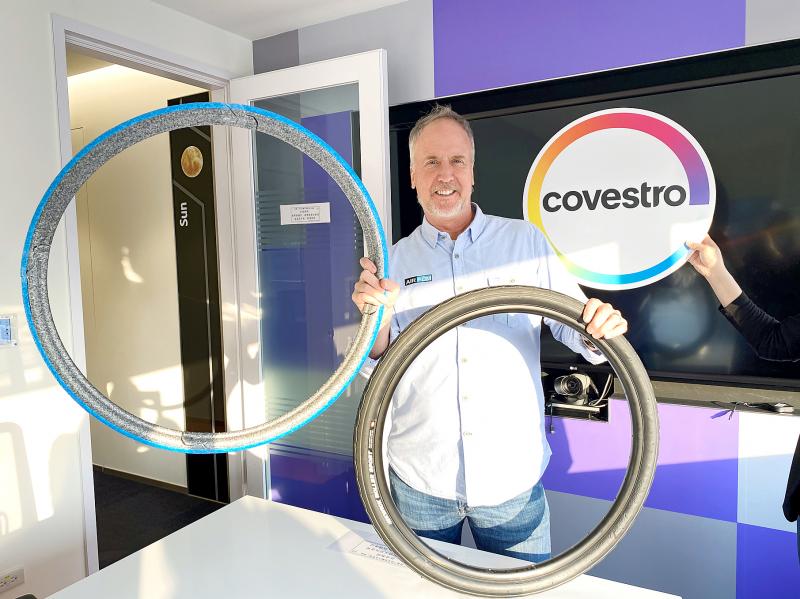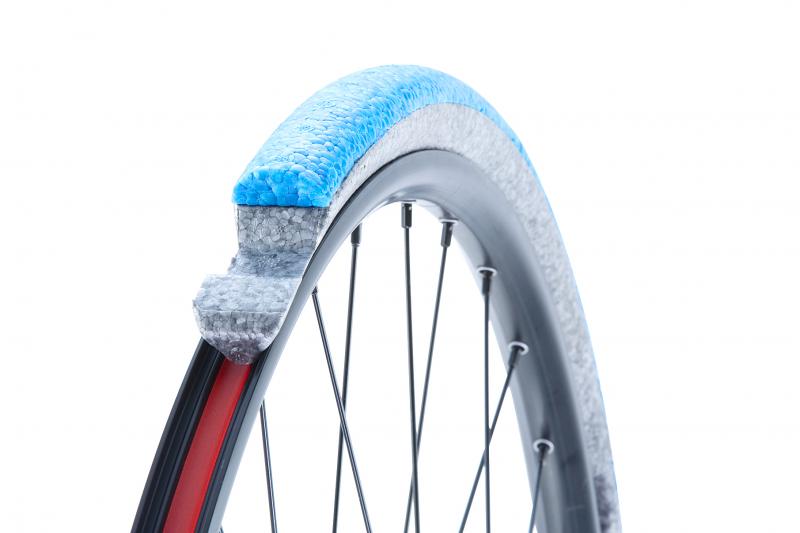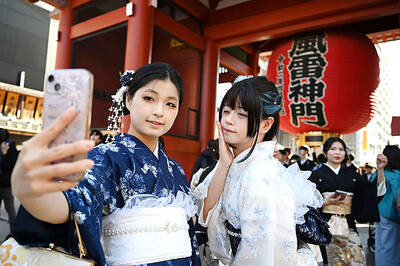Getting a flat tire is a nightmare for cyclists, sending home early any rider who had ventured outdoors without a repair kit or spare inner tubes.
Although punctured tires have long been a pain point for cyclists, the problem has never been effectively resolved, despite the bicycle industry going back centuries.
A few products have been developed to help reduce the likelihood of flat tires: puncture-resistant tires, which are thicker than usual tires or come with a protective layer; anti-puncture tapes, which are placed between the tire and inner tube to offer extra protection; and tubeless systems that use sealant to close small punctures.

Photo: Kao Shih-ching, Taipei Times
However, none of them can completely prevent a punctured tire. This has prompted industry experts to try a different approach in the past few decades, with the goal of eliminating air from bicycle tires.
The idea is simple: If there is no air in the tires, there will be no chance of a flat tire. To achieve this, experts developed airless tires, which are also called solid tires.
Unlike traditional bicycle tires and tubes, which are made of rubber and need to be inflated, airless tires are made of various materials, depending on the manufacturers.

Photo courtesy of Metro Aim International Ltd
Although the concept sounds revolutionary, early products were not popular among cyclists, due to their reputation for being heavier, slower, uncomfortable and having a higher rolling resistance.
“I would rather deal with occasional punctures than lose the fun in riding,” a male cyclist surnamed Hsieh (謝) said.
Metro Aim International Ltd (艾逸豐), a Samoan start-up whose operations are based in Taichung, is trying to reverse the negative impression of airless tires with its newly developed “Air Fom.” Its products have already been installed on shared bikes in cities in Belgium, France, Germany, the Netherlands and the UK.
Air Fom, released in November 2018, uses a special chemical material — expanded thermoplastic polyurethane (TPU) — which is widely used in the soles of sports shoes.
Metro Aim founder and chief executive officer Mark Peterman said he was inspired by TPU used in soles during a visit to Vietnam in 2016.
“I thought it [TPU] might be an excellent material for airless tires, as it is highly elastic, lightweight and durable. The footwear industry and the bicycle industry were like two paths that never crossed, but we did cross the paths,” Peterman told the Taipei Times in an interview in Taipei on Feb. 1.
Peterman, who has 35 years of experience in the cycling industry, had looked for ways to resolve flat tires throughout his career until finding TPU.
“Sometimes an innovative product requires a new material, not a new design. The use of TPU made our product concept possible,” he said.
Peterman had nothing to refer to when researching and developing his product concept, as at that time all airless bicycle tires were made of older materials, such as polyurethane, but he finally had a breakthrough after about two years of tests with Covestro AG, which supplied the TPU, he said.
“As we never used expanded TPU on bicycle tires and we want to simulate the pneumatic tires, it took many tests to know at which density the expanded TPU would be the most suitable for bicycle tires,” Hong Kong-based Wilson Chan (陳永昌), the head of business development at Covestro’s APAC TPU center, said by telephone.
The rice-like TPU beads have a high density of about 1.2 grams per cubic centimeter (g/cm3), but after they are processed via injection molding into expanded TPU, their density falls, Chan said, adding that for instance, the density of expanded TPU used in shoe soles is 0.18g/cm3.
Finding the right density is crucial, as it affects product performance, such as weight and hardness, Chan said, adding that airless tires cannot be too soft, or cyclists would feel like they are riding on tires that have not been inflated enough.
One of expanded TPU’s properties is high energy return, which means Air Fom tires do not deform even if left standing on the ground for a long period, which is a property other solid bicycle tires do not possess, Peterman said.
Air Fom can produce up to 60 percent rebound compared with air-filled tires, which is higher than the 25 to 30 percent produced by airless tires made of other materials, such as EVA and older foam technologies, he said.
As expanded TPU and expanded polypropylene, which is another material used in Air Fom, are lightweight, Air Fom tires weigh 280g to 320g per wheel, he said.
Although that is about 60g to 140g heavier than an inflated tube, the weight difference should be worth it, given that it eliminates the risk of flat tires, Peterman added.
Air Fom tires simulate air pressure of 40 to 70 pounds per square inch, which is close to the range in inflated tires used in commuter bikes, he said, adding that the company can manufacture products with different simulated air pressures.
“Overall, cyclists would not feel any difference when riding on Air Fom,” Peterman said. “When they take big hits, they might feel stiffer, but their rims would not get [damaged].”
Another feature of Air Fom is that it was designed to replace the inner tube and functions as an insert between the outer tire and the rim. Most airless bicycle tires, on the other hand, are designed as a whole tire without a rubber tire on top, such as those made by South Korea-based Tannus Co Ltd.
The feature enables cyclists who want to try airless products to continue using their current rubber tires instead of discarding them, and protects the foam-like Air Fom insert from ultraviolet rays, and chemical and water damage, Peterman said.
“In that way, it would always function correctly,” Peterman said, adding that the insert lasts at least 5,000km.
Although Peterman is confident that his product can outperform other airless tires in terms of ride quality and the elimination of flat tires, he still has to deal with consumers’ low acceptance of the innovative product.
When Peterman promoted his product at local bicycle shops, some business owners refused it without even trying, he said.
“They [bike shops and cyclists] just don’t believe the idea of airless tires, as they did not have good riding experience with the solid tires which were developed early,” Peterman said.
One of the most effective ways to promote Air Fom is to participate in trade shows worldwide to give distributors and cyclists a chance to ride on the foam-like products, but it was disappointing that many shows have gone online or were canceled due to the COVID-19 pandemic, Peterman said.
Faced with travel restrictions, Peterman and his colleagues held videoconferences with potential clients and sent samples, but the marketing effect was not comparable, he said.
As Air Fom is more expensive than conventional bicycle tubes, with the former’s retail price set at NT$750 per wheel and the latter’s ranging from NT$100 to NT$200, original equipment manufacturers mostly rejected the product, as they have strict cost controls, Peterman said.
“Some people cannot get it why our product is high-priced, as they misunderstand that our product is made of expanded polystyrene. The two materials are distinct,” he said.
While regular consumers have yet to appreciate the benefits of Air Fom tires, some bike-sharing operators in Europe already have.
Metro Aim in May 2019 began providing Air Fom inserts to operators and three are using the product in five European countries, Peterman said.
Bike-sharing programs and other commercial programs, such as leasing, make up 50 percent of Metro Aim’s revenue, while another 35 percent comes from the aftermarket business and 15 percent from bike original equipment manufacturers, he said.
Metro Aim, which has assigned two Chinese factories to manufacture its products, aims to produce 250,000 sets of Air Fom inserts this year, expecting rapid growth in bike-sharing, bike leasing and electric bikes to benefit its business. It is expecting to ship more than 25,000 sets to bike-sharing operators this year.
It might be still a long time before airless tires dominate the market, as the combined market share of all solid bicycle tires is less than 1 percent, Peterman said.
Asked how long it would take cyclists to switch to airless products, Peterman said: “10 years.”
For the company to thrive and secure a niche market, it needs to work with local bicycle manufacturers, standardize its foam inserts and make sure Air Fom and bike makers’ wheels are compatible, an Industrial Development Bureau official surnamed Tong (童) told the Taipei Times.

Shiina Ito has had fewer Chinese customers at her Tokyo jewelry shop since Beijing issued a travel warning in the wake of a diplomatic spat, but she said she was not concerned. A souring of Tokyo-Beijing relations this month, following remarks by Japanese Prime Minister Sanae Takaichi about Taiwan, has fueled concerns about the impact on the ritzy boutiques, noodle joints and hotels where holidaymakers spend their cash. However, businesses in Tokyo largely shrugged off any anxiety. “Since there are fewer Chinese customers, it’s become a bit easier for Japanese shoppers to visit, so our sales haven’t really dropped,” Ito

The number of Taiwanese working in the US rose to a record high of 137,000 last year, driven largely by Taiwan Semiconductor Manufacturing Co’s (TSMC, 台積電) rapid overseas expansion, according to government data released yesterday. A total of 666,000 Taiwanese nationals were employed abroad last year, an increase of 45,000 from 2023 and the highest level since the COVID-19 pandemic, data from the Directorate-General of Budget, Accounting and Statistics (DGBAS) showed. Overseas employment had steadily increased between 2009 and 2019, peaking at 739,000, before plunging to 319,000 in 2021 amid US-China trade tensions, global supply chain shifts, reshoring by Taiwanese companies and

Taiwan Semiconductor Manufacturing Co (TSMC) Chairman C.C. Wei (魏哲家) and the company’s former chairman, Mark Liu (劉德音), both received the Robert N. Noyce Award -- the semiconductor industry’s highest honor -- in San Jose, California, on Thursday (local time). Speaking at the award event, Liu, who retired last year, expressed gratitude to his wife, his dissertation advisor at the University of California, Berkeley, his supervisors at AT&T Bell Laboratories -- where he worked on optical fiber communication systems before joining TSMC, TSMC partners, and industry colleagues. Liu said that working alongside TSMC

TECHNOLOGY DAY: The Taiwanese firm is also setting up a joint venture with Alphabet Inc on robots and plans to establish a firm in Japan to produce Model A EVs Manufacturing giant Hon Hai Precision Industry Co (鴻海精密) yesterday announced a collaboration with ChatGPT developer OpenAI to build next-generation artificial intelligence (AI) infrastructure and strengthen its local supply chain in the US to accelerate the deployment of advanced AI systems. Building such an infrastructure in the US is crucial for strengthening local supply chains and supporting the US in maintaining its leading position in the AI domain, Hon Hai said in a statement. Through the collaboration, OpenAI would share its insights into emerging hardware needs in the AI industry with Hon Hai to support the company’s design and development work, as well